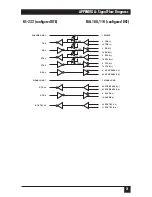
17
CHAPTER 5: Troubleshooting
If you experience any difficulty with your RS-232/MIL 188 setup, follow these
steps to find a solution:
1. Make sure that all the devices in the setup are configured properly.
Check DIP switches and jumpers in each device to ensure they are set
correctly.
2. Test your RS-232 and MIL 188 equipment to discern if they are the
source of the trouble.
3. After checking that both the RS-232 and MIL 188 devices are operating
correctly, check the connections between all your devices, and check that
the power supplies on all three are functioning properly.
4. Next, if you are using an asynchronous RS-232
↔
MIL Standard Interface
Converter, you can perform a data loopback test. (If you are operating a
synchronous RS-232
↔
MIL Standard Interface Converter, call Technical
Support for more troubleshooting help.)
There are several versions of the loopback test, depending on which mode
(MIL 188C or MIL 188/114) you have the Converter set up for.
T
HE LOOPBACK TEST WITH THE
C
ONVERTER IN
MIL 188-C M
ODE
.
If the Converter is in 188-C mode, the loopback test will help you check the
data and handshaking between the RS-232 device to the MIL 188C device.
Perform this test before calling Technical Support. The information from
this test will help them to aid you in troubleshooting the interface converter.
The loopback-test procedure:
Connect a PC or dumb terminal to the RS-232 side of the interface converter
via a cable with a DB25 male connector. (This cable
must
have straight-
through pinning;
none
of its leads can be shorted together. Plus, the RS-232
side of the converter must be set to DCE.) Then, on the MIL 188C interface,
short Pin 20 to pins 6 and 8 together, pins 4 and 5 together, and pins 2 and 3
together. The MIL 188C side of the interface converter must be set to DTE.
5. Troubleshooting




























